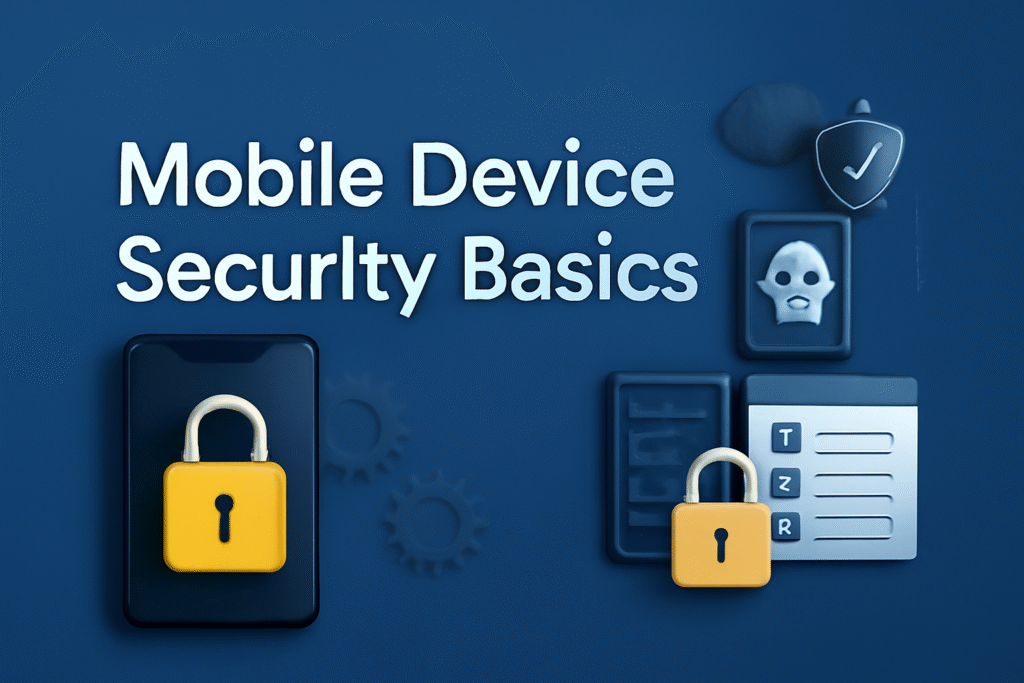
In our increasingly digital world, mobile devices have become central to our daily activities. From storing personal information to conducting financial transactions, smartphones and tablets handle an immense amount of sensitive data. This module introduces the key concepts of mobile device security, outlining common threats, security features, and best practices for keeping mobile devices safe.
Why Mobile Device Security Matters
Mobile device security protects your devices from cyber threats, malware, data breaches, and physical theft. For both smartphone repair professionals and ethical hackers, understanding mobile security is crucial. Not only will you repair and protect devices, but you’ll also be able to assess and patch security vulnerabilities in mobile systems.
Module Overview
1. Introduction to Mobile Device Security
Mobile security is the practice of protecting mobile devices (smartphones, tablets, wearables) from unauthorized access, malware, theft, and data breaches. As mobile devices become a primary target for cybercriminals, securing them is essential for both users and technicians.
What You Will Learn:
- What mobile security is and why it’s crucial.
- The security architecture of Android and iOS devices.
- Common threats to mobile devices and how they exploit weaknesses.
2. Mobile Operating Systems and Security Features
Both Android and iOS have unique security features. Understanding these will help you ensure that the devices you repair are secured, and that vulnerabilities are identified and patched.
Android Security Features
- Google Play Protect: Google’s built-in security tool scans apps for malware and harmful behavior.
- App Sandboxing: Prevents apps from accessing data from other apps unless explicitly permitted.
- Encryption: Android uses AES-256 encryption to protect data on the device.
- Secure Boot & Verified Boot: Ensures only trusted software loads on the device during startup.
iOS Security Features
- App Store Review Process: All apps undergo a strict review process to ensure they meet security standards.
- App Sandboxing: Ensures apps are isolated from each other to prevent data leaks.
- Secure Enclave: A dedicated chip that stores sensitive information like passwords, biometric data, and encryption keys.
- Full Disk Encryption: iPhones are fully encrypted by default to protect user data.
Comparison: Android vs iOS
Learn more about Android and iOS security differences.
3. Common Mobile Security Threats
Mobile devices face various security risks that can compromise users’ privacy and personal data. Here are some of the most common threats:
Malware
- Trojan Horses: Malicious apps disguised as legitimate apps that steal data or control devices.
- Spyware: Apps that track user activities, gather private information, and send it to third parties.
- Adware: Software that generates intrusive ads, potentially slowing down devices and compromising user experience.
- Ransomware: Malware that locks a device or encrypts data, demanding payment to unlock it.
Phishing Attacks
- SMS Phishing (Smishing): Fake text messages designed to steal sensitive information.
- Email Phishing: Malicious emails trick users into revealing passwords, credit card information, or personal data.
- App Phishing: Fake apps designed to steal user credentials and personal information.
Man-in-the-Middle (MITM) Attacks
MITM attacks occur when hackers intercept and alter the communication between a user’s mobile device and a server. This type of attack is common on unsecured public Wi-Fi networks.
Device Theft and Loss
When mobile devices are lost or stolen, the personal data on them can be accessed. Protecting data through device encryption and remote wipe features can mitigate this risk.
Unpatched Vulnerabilities
Failing to update a device’s software can leave it open to exploits. Zero-day vulnerabilities are particularly dangerous because they target security flaws that have not yet been discovered or patched.
4. Mobile Security Best Practices
Here are essential best practices to keep your devices secure:
Use Strong Authentication
- Set strong PINs or passwords to protect access to your device.
- Enable Two-Factor Authentication (2FA) for online accounts accessed via mobile devices.
- Use biometric authentication (Face ID, Fingerprint) for an added layer of security.
Keep Software Updated
- Automatic Updates: Ensure the device receives regular security updates and patches.
- Manual Updates: Check for OS and app updates frequently to close known vulnerabilities.
App Permissions
- Review the permissions that apps request and ensure they only ask for necessary data.
- Revoke permissions for apps that don’t need access to sensitive data like contacts or location.
Encrypt Your Device
- Encrypting your device ensures that data is protected even if the device is stolen.
- Both Android and iOS offer encryption by default, but ensure it’s activated.
Avoid Public Wi-Fi for Sensitive Activities
- Public Wi-Fi is a common target for MITM attacks. Use a VPN when accessing sensitive information over public networks.
Install Mobile Security Apps
- Install antivirus and mobile security apps such as McAfee, Norton Mobile Security, or Lookout.
- Enable Google Play Protect (Android) or use Apple’s built-in security features (iOS).
Recommended Security Apps:
5. Mobile Privacy and Data Protection
Protecting privacy is a critical part of mobile security.
Location Tracking and Privacy Management
- Only grant apps location access when necessary.
- Manage your location settings by turning off location sharing in apps and browsers.
Backup and Secure Storage
- Use cloud backups (Google Drive, iCloud) to keep data safe in case of device loss or damage.
- Encrypted backups ensure that your data is secure while stored in the cloud.
Private Browsing
- Use Incognito mode for private browsing to avoid tracking by websites.
- Consider privacy-focused browsers like Brave or DuckDuckGo for additional privacy protection.
6. Mobile Device Security Assessment (Practical)
Hands-On Exercises:
- Audit a Device: Perform a mobile security audit on an Android or iOS device, checking for vulnerabilities like outdated software, unsecured apps, and insufficient app permissions.
- Penetration Testing: Use tools like Wireshark or Burp Suite to simulate a MITM attack on a mobile device in a controlled environment.
Conclusion: Mobile Device Security Is Vital
Mobile security is an essential aspect of smartphone repair and ethical hacking. By mastering the fundamentals of mobile device security, you will be well-equipped to not only fix devices but also protect them from cyber threats. Whether you’re repairing a device or securing it for ethical hacking purposes, understanding these security principles will set you apart in the tech industry.
For further reading on mobile security, explore the following resources:
